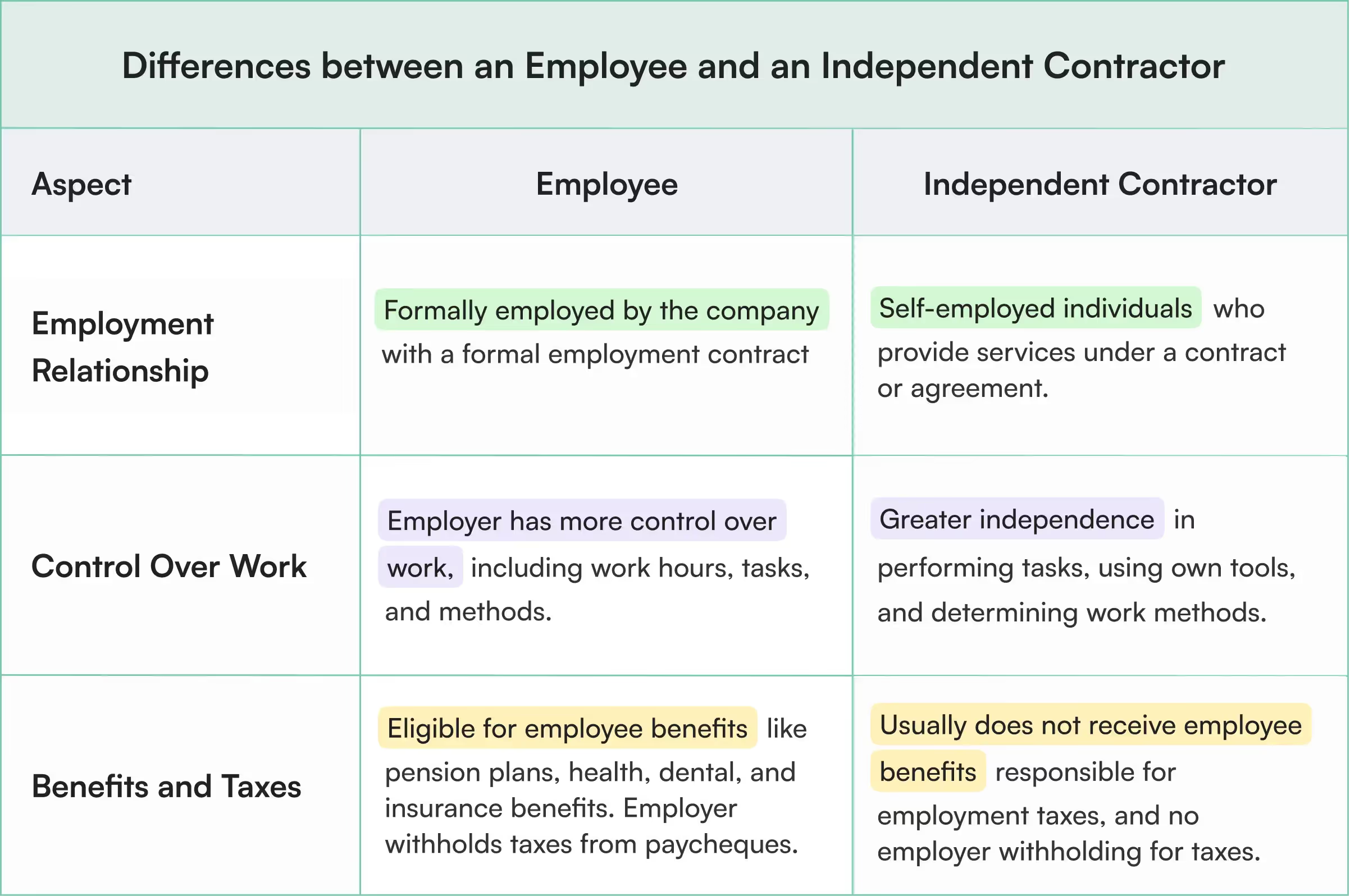As an employer operating a global company, you may be hiring more than one type of worker. It’s most likely that the bulk of your workforce is made up of both formal employees and external contractors.
Say you get to the end of an employee’s contract. They had a great time with your company, but life seems to be getting in the way of the workload they can realistically take on. As an employer, you may wonder if it’s possible to take a talented performer back in a contract capacity.
So what’s the difference between the two? Working as an employee and working as a contractor (aka independent contractor or freelancer) have a few significant differences in terms of employment status, responsibilities, benefits, tax obligations, and legal implications. How do these impact your human resources and hiring practices?
Here are a few key distinctions between these terms and what you should know before bringing an employee back on contract.

Working as a Contractor vs. Employee
So who is an employee and who is an independent contractor anyway?
Employees:
- Are formally employed by your company. Employees work for a specific employer under a formal employment contract. The employer typically has more control over the employee's work, including work hours, tasks, and how the work is performed.
- This comes with a general set of rights, both determined by internal company policy and by law in the region where they work. Employees usually enjoy benefits like pension plans, as well as health, dental and insurance plan benefits. Employees generally have tax withheld on their paychecks by an employer.
Contractors:
- Independent contractors are self-employed individuals. The contractor is in essence a business owner who provides services to clients under a contract or agreement. Independent contractors work the hours they choose, often giving them more work-life balance. That said, they may work for multiple clients.
- Are considered independent entities. A contractor rarely receives the same benefits as an employee, such as vacation pay. They also take care of their self-employment tax. Plus, employers don't need to pay a social security tax on wages paid to independent contractors.
How much control and independence does each class of worker have?
Employee: Employers often have more control over employees, directing their work, providing tools and resources, and setting the conditions of employment.
Contractor: Contractors have greater independence in how they perform the contracted tasks. They may use their own tools, determine their work methods, and have more flexibility in choosing when and where to work.
Benefits and Protections
Employees typically receive benefits from their employers, such as health insurance, paid time off, retirement plans, and sometimes job protections under labor laws.
Contractors are responsible for their own benefits, including health insurance and retirement planning. They do not receive employee benefits from the client and are not covered by the same job protections.
Tax Requirements
Employers withhold income taxes, social security, and things like Medicare in the US from employees' paychecks as per the Internal Revenue Service and the Fair Labor Standards Act. Employees receive T4, W-2 or whatever form may be relevant in their country of work showing their annual income.
Contractors are responsible for paying their own taxes. That includes self-employment taxes. When contractors work for clients, they receive payment forms or invoices that they need to keep track of come tax time.
Legal Implications and Regulations
So how do these roles differ from a legal standpoint? Employees are covered by labor laws that give them rights to minimum wage, overtime pay, workplace safety, anti-discrimination protections, and other coverage.
Contractors are not covered by the same labor laws as employees. They have a business-to-business relationship with clients. This means they might need to negotiate terms, including payment, in their contracts.
Length of Engagement
For employees, employment relationships are normally ongoing and indefinite (except in cases like term work, summer jobs, etc.), with the possibility of termination based on company policies or labor laws.
Contractors are usually hired for a specific project or period of time. Often they’re looked to for their expertise and may work on short-term projects or provide specialized services.
You need to make sure you’re accurately classifying workers as employees or contractors based on the nature of the work and applicable laws in your jurisdiction. Misclassifying workers has legal and financial consequences. If you're unsure about the classification, an EOR service like Borderless or a legal counsel can be the best way to ensure you’re legally compliant.
Can You Hire Independent Contractors as Employees or Rehire a Former Employee as a Contractor?
If both parties agree and if the nature of the work and the employment relationship meet the legal criteria for employee status in your jurisdiction, rehiring employees as contractors is legally accepted. First, you’ll have to take a few specific steps to make sure you’re in compliance with labor laws and regulations.

Assess Your Employment Relationship
What existing relationship do you have with your former employee? Review their role and performance to determine if new work aligns with the criteria for contractors under your local labor laws. Key factors may include the level of control, independence, the permanence of the relationship, benefits, and other employment-related considerations.
Negotiate and Offer Employment
If both parties agree to the transition, negotiate the terms of employment, including compensation, benefits, work hours, job duties, and any other relevant terms. Ensure the employee-turned-contractor understands the change in status and the implications.
Draft a Contractor Agreement
Write out a comprehensive employment agreement outlining the terms of the employment relationship. Include details about the employee's role, responsibilities, compensation, benefits, working conditions, termination procedures, and any other relevant clauses.
Terminate the Employee Agreement
If you have an old employee agreement with your soon-to-be contractor, follow the termination process outlined in the agreement or follow standard termination procedures based on the terms of the contract and local laws.
Onboard as a Contractor
Complete the necessary paperwork and processes for onboarding the worker as a contractor. This can include showing them an alternate procedure to track taxes, providing information about company policies, setting up payroll if needed, and any other standard onboarding procedures. Since they’ve already worked for you, you may be able to streamline this process.
Compliance with Labor Laws
Make sure that the transition complies with all relevant labor laws, like minimum wage, overtime regulations, and any other employment-related regulations in your jurisdiction.
Update Job Role and Responsibilities
If the nature of the work changes with the transition to a contractor, update the job description and make sure responsibilities align with the new role.
Communication
Clearly communicate the change in status to the rest of the organization, as it may impact team dynamics and reporting structures.
Maintain Compliance
Ensure ongoing compliance with all employment-related laws and regulations for the employee.
How to Stay Compliant
Rehiring an employee as a contractor requires several steps to ensure a legally compliant and smooth transition. You should consult with legal professionals or HR experts at some point in your process so you know you're following labor laws and regulations in your jurisdiction. Here are some general steps you can consider, but remember to adapt them based on your specific situation and local laws:

Determine Contractor Status
Does your worker meet the legal requirements to qualify as a contractor rather than an employee? Make sure you assess what the rules are for where they’re working. Contractor status has many factors like the type of work, level of control, and independence. If you’re not sure, ask! Borderless can help you better understand worker status and misclassification risk.
Negotiate Contract Terms
Work with the individual to agree on the terms of the contractor relationship. This includes compensation, scope of work, duration of the contract, deliverables, deadlines, and any other relevant details.
Create a Contractor Agreement
Draft a clear and comprehensive contractor agreement that outlines the terms discussed. Make sure your agreement includes details like the contractor's responsibilities, payment terms, IP rights, confidentiality, termination conditions, and any other relevant clauses.
Wait for a Cooling-Off Period (if applicable)
In some jurisdictions you may be required to follow a waiting period before rehiring former employees as contractors. This is to prevent misuse of contractor status to get out of employee responsibilities.
Know the local laws and follow the waiting period, if necessary.
Onboard as a Contractor
Once the cooling-off period (if applicable) has passed and your worker is no longer considered an employee, onboard them as a contractor. This means giving them with the necessary tools they’ll need to complete work, access to company systems or networks, and information to perform their contracted tasks.
Tax and Benefits Considerations
Contractors look after their own taxes and benefits. Make sure they understand their tax obligations and aren’t expecting employee benefits like healthcare, paid time off, etc.
Maintain Contractor Relationship
Maintain clear communication with the contractor, provide any necessary support, and ensure the terms of the contractor agreement are upheld.

What to Consider Before You Rehire an Employee
Though it can often be a convenient option for both parties, there are several things to consider for a smooth, legally compliant transition. Here's what you should know before rehiring a former employee as a contractor:
Legal and Regulatory Considerations
How does your potential rehire fit in with labor laws? Understand the labor laws and regulations in your jurisdiction that apply to rehiring former employees as contractors.
Contractor vs. Employee Classification
Carefully assess the nature of the work your worker will be performing as a contractor. Make sure the workload and the working relationship meet the criteria for contractor status in your jurisdiction. Key factors include the level of control, independence, scope of work, etc. Write up a clear contractor agreement that outlines the terms of the contractor relationship like details on scope of work, deliverables, payment, deadlines, and more.
Intellectual Property and Confidentiality
Address ownership of intellectual property created during the contractor engagement. Who has the right to the work the contractor produces? Include clauses to protect confidential information that would damage your organization's reputation if shared externally.
Termination and Renewal
Review the terms for contract termination and renewal in the contractor agreement. This makes sure work terms and expectations are clear for both parties. It will help you avoid misunderstandings.
Documentation
Keep thorough records of the entire rehiring process, including the termination of the previous employment, the cooling-off period (if applicable), the contractor agreement, and any other relevant documents.
Remember, it's essential to seek professional advice, such as consulting with legal experts or HR professionals, to ensure that you're following all applicable laws and regulations when rehiring a former employee as a contractor.

How Can an EOR Help?
An Employer of Record (EOR) like Borderless can provide valuable assistance when rehiring a former employee as a contractor. As a third-party entity, EORs serve as the official employer for tax and legal purposes while the contractor works for your company. Here's how an EOR can help with the process:
- Legal Compliance: EORs are experienced in employment law and can ensure that the rehiring process aligns with local labor regulations. They can help you navigate legal considerations, ensuring that the contractor classification is appropriate and that you're compliant with relevant laws, including tax and labor regulations.
- Contractor Classification: EORs can help determine if the individual can legally be classified as a contractor based on the nature of the work and other criteria. This ensures that you're not misclassifying employees as contractors, which can lead to legal issues.
- Cooling-Off: If there's a mandatory waiting period after you terminate an employment relationship before rehiring the same individual as a contractor, an EOR can help you understand and comply with this requirement.
- Contractor Agreements: EORs often have experience in drafting contractor agreements. They can create a comprehensive and legally sound contract that outlines the terms of the contractor engagement, protecting both parties interests.
- Payroll and Benefits: EORs handle payroll processing and tax compliance for contractors to make sure a contractor is properly paid, and taxes are withheld according to regulations. They can also advise the contractor on tax-related matters if needed.
- Benefits Transition: EORs can help communicate a change in benefits to the former employee, making sure they understand that, as a contractor, they have to account for their own benefits.
- Risk Management: By acting as the legal employer of the contractor, the EOR takes on certain liability, mitigating your company's potential risks in the rehiring process.
- Record Keeping: EORs maintain records related to the contractor engagement, which can be helpful for compliance purposes and future reference.
- Renewals and Terminations: EORs can make the renewal of the contractor engagement easier and handle any necessary terminations while complying with the terms of the contractor agreement and local laws.
- Expert Advice: EORs have expertise in employment matters. They can provide guidance on best practices, offer insights into local labor market conditions, and help you make informed decisions about the rehiring process.
By partnering with an EOR, you get a smoother and legally compliant rehiring process, less admin burdens and legal risks, while focusing on the productive work that the contractor will contribute to your organization.
Make Borderless your chosen EOR for hiring contractors and employees, no matter where you work. Book a demo with us to see how we’ll help you stay compliant and grow your team anywhere in the world.
Disclaimer
Borderless does not provide legal services or legal advice to anyone. This includes customers, contractors, employees, partners, and the general public. We are not lawyers or paralegals. Please read our full disclaimer here.



.png)





